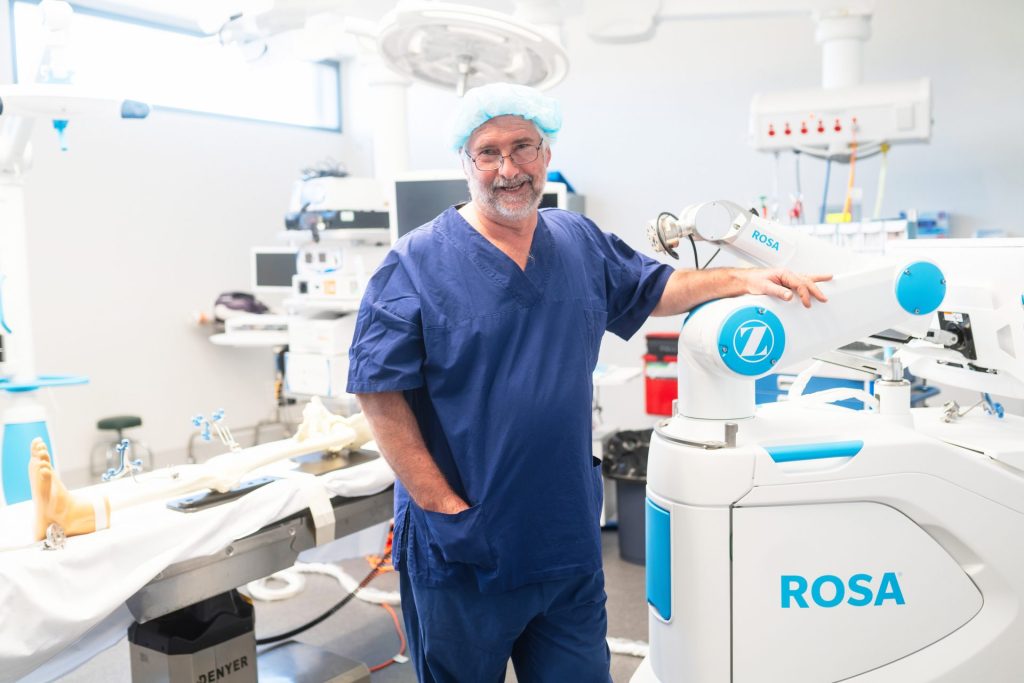
Hip Fractures
Hip fractures are usually breaks in the top part of the femur (thigh bone), rather than the hip socket. Two parts of this bone are prone to breaking – the femoral neck, where the ball-shaped top of your thigh bone meets the rest of your femur, and the intertrochanteric region, which is the part of your thigh bone that juts outward.
At Orthopaedics SA, our team of highly trained surgeons assesses and treat all forms of hip fractures. Ask your doctor for a referral to one of our specialists.
There are two main types of hip fractures:
Femoral neck fractures occur just below the ball of the hip joint, where the femur narrows. These fractures are particularly concerning due to the potential disruption of the blood supply to the femoral head, which can lead to complications such as avascular necrosis (bone tissue death) and nonunion (failure of the bone to heal). Patients with femoral neck fractures often face a higher risk of long-term mobility issues and may require surgical intervention, such as internal fixation or hip replacement, depending on the severity of the fracture and the patient’s overall health.
Intertrochanteric fractures occur in the region between the greater and lesser trochanters (the bony prominences of the upper femur). These fractures generally have a better prognosis compared to femoral neck fractures, as the blood supply is less likely to be compromised. Treatment typically involves surgical fixation using plates, screws, or a combination thereof. The recovery process and rehabilitation may differ from femoral neck fractures due to the location and nature of the injury.
The signs and symptoms of a hip fracture usually come on suddenly and immediately after the fracture happens, but may also appear gradually and worsen with time. They may include:
· Pain – usually severe, sharp, and felt in the hip or groin. You may feel it radiating through the thigh or buttock.
· Inability to put weight on your leg (such as to stand or walk)
· Bruising and swelling around the hip
· Inability to lift, move, or rotate your leg
· Your injured leg appearing shorter than the other one
· Your leg rotating outwards while at rest
· Deformity – your hip may have an unusual shape or look like it’s out of position.
Remember that your own experience is unique and you may have different symptoms. If you suspect that you have a hip fracture, see your doctor immediately and request a referral to Orthopaedics SA for leading treatment.
Most hip fractures result from a traumatic event which places unusual impact on the hip bone, such as a fall or a vehicle crash.
Especially in older people who have bone-weakening conditions like osteoporosis, hip fractures can be caused by twisting or pivoting suddenly. Severe osteoporosis may cause hip fractures during normal activities, such as walking or standing up from a chair.
Though less common, some hip fractures are sports injuries. These tend to be stress fractures and develop in long-distance runners or in military recruits during basic training, though some result from improper landings or tackles in high-impact sports.
Other factors can increase your risk of developing hip fractures. These include:
· Age – bone density and muscle strength can decrease with age, making you more vulnerable to fractures
· Gender – women have higher risks of hip fractures, especially after menopause.
· Level of activity – regular activity promotes bone and muscle strength.
· Medical conditions – conditions like Parkinson’s can reduce your balance, and some thyroid disorders or osteoporosis reduce your bone strength.
· Medications – many drugs that improve sleep can reduce your balance and increase your risk of falls, while others can affect your bones’ ability to heal from injuries.
- Osteoporosis: This condition weakens bones, making them more prone to fractures even with minimal trauma.
- Age: As people age, bones naturally lose density, and the risk of falls increases, both of which elevate the likelihood of hip fractures.
- Gender: Hip fractures are more common in women, partly due to lower bone density and the impact of menopause on bone health.*
- Previous Fractures: A history of fractures increases the likelihood of future fractures, as it may indicate underlying bone fragility.
- Lifestyle Factors: Poor nutrition, particularly calcium and vitamin D deficiencies, along with physical inactivity, can weaken bones and muscles, increasing the risk of hip fractures.
If a hip fracture is not treated properly, it can lead to several serious complications. Delayed treatment can result in prolonged immobility, leading to muscle atrophy and joint stiffness. Prolonged bed rest can cause deep vein thrombosis (DVT), which can lead to life-threatening pulmonary embolisms. Immobility and surgical interventions can increase the risk of infections, including pneumonia and surgical site infections. Without early intervention, a hip fracture can lead to chronic pain, reduced mobility, and a significant decline in the quality of life.
In most cases, your hip injury will be assessed by a doctor in a hospital emergency department. The doctor will ask you questions about how the injury happened, your pain levels, and if you have any other physical or mental health conditions. They may also inspect your hip and ask you to try and move it in certain ways.
If they suspect a hip fracture, they will usually order imaging tests to confirm it. These may include:
· X-rays – these imaging tests let doctors see any abnormalities in the hip’s shape or structure. Most hip fractures can be diagnosed with x-rays.
· MRI scans – using magnetic imaging instead of x-rays, MRIs can detect some hip fractures that are too fine to be seen on x-rays. They can also show damage to the soft tissues and other structures in your hip.
· CT scans – CT scans use more powerful x-rays to create cross-section images of your hip bones. Your doctor may request a hip CT scan to learn more about the fracture.
Most hip fractures are treated with surgery in some form, though your orthopaedic surgeon may recommend different approaches depending on the nature of your injury. If you get admitted to the hospital with a hip fracture, your medical team will aim to operate within 48 hours.
Your exact treatment options will depend on the severity and location of your fracture, your age, your lifestyle needs, and your overall bone health. Under guidance from your surgeon at Orthopaedics SA, your treatment options for a hip fracture may include:
· Internal fixation – if your fracture is not large or significantly displaced, your orthopaedic surgeon may place metal screws, pins, or rods in your hip to hold the bones in place as they heal.
· Partial hip replacement surgery (hemiarthroplasty) – about 50% of all hip fracture cases need some form of hip replacement, whether partial or total. If your fracture is inside the hip socket, your surgeon may recommend replacing the top part of your thigh bone which connects to your hip socket with a prosthetic part.
· Total hip replacement surgery – more severe fractures or fractures in people with active lifestyles may require a total hip replacement. They are particularly recommended if your hip bone has poor blood supply and may not heal the fracture fully.
Rehabilitation is a critical component of recovery following a hip fracture, and typically involves:
- Physical therapy, focusing on restoring strength, flexibility, and balance to help patients regain mobility and independence.
- Mobility aids, such as walkers, canes, or crutches may be necessary during the early stages of recovery.
The recovery process can vary depending on the type of fracture and the patient’s overall health, but most patients an expect a gradual improvement over several months, with full recovery potentially taking up to a year.
Rehabiltiation not only aids in physical recovery, but it also plays an important role in preventing future fractures by improving strength and balance.
Adjusting to life after a hip fracture requires practical strategies and support.
- Home Modifications: Installing grab bars, removing trip hazards, and arranging for a more accessible living space can help prevent falls and ease daily activities.
- Pain Management: Pain relief is essential, both during recovery and in the long term. Options may include medications, physical therapy, and complementary therapies.
- Support Systems: Engaging with support groups, occupational therapists, and community resources can provide both emotional and practical support, helping patients and caregivers navigate the challenges of living with a hip fracture.
It’s often said that the best treatment is prevention.
· Get enough calcium and vitamin D – these two nutrients promote bone strength, making your hip less likely to fracture in the event of a fall.
· Manage osteoporosis – if you suffer from osteoporosis, your doctor may recommend bisphosphonate medications that slow bone loss. This helps keep your bones strong and makes them less susceptible to fractures.
· Stay active – weight-bearing exercises help maintain bone density and keep you healthy overall. Regular activity can also improve your sense of balance and muscle strength, preventing falls.
· Avoid tobacco and alcohol use – as well as reducing your bone density and making you more susceptible to fractures, using too much of either can make you dizzy and increase your risk of falls.
· Keep your home free from trip hazards – loose rugs, cables, and excess furniture can cause you to trip and fall. Ensuring that your house is well-lit can also help prevent falling at home.
· Check your eye health – being unable to spot hazards increases your risk of falling and developing a hip fracture significantly.
· Use walking aids if needed – a cane or walker may prevent falls by helping you balance, or may help reduce impact on a painful hip. Talk to your doctor about finding the right walking aid for you.
· Wear a hip protector – These are made of padded material and plastic shields which attach to specifically designed underwear. When worn under the clothes, they can absorb the shock from a fall and divert the impact away from vulnerable areas.
· Use the FRAX tool – Developed by the World Health Organisation, FRAX is a risk assessment tool that helps predict the likelihood of fractures in people aged 40-90. You can learn more about it here.
If you’re needing support for a hip fracture, schedule a consultation with Orthopaedics SA’s orthopaedic surgeons and get expert hip surgery care in Adelaide.
Book an appointment with our orthopaedic specialists
Book an appointment











